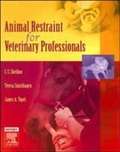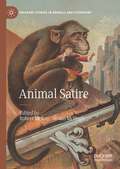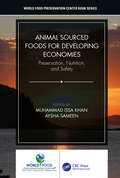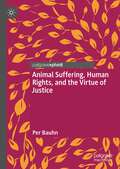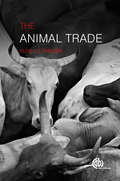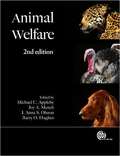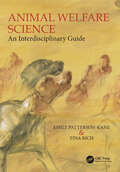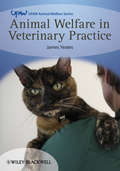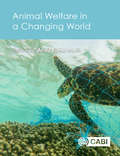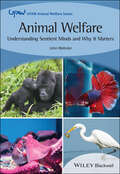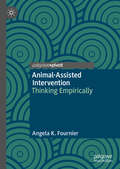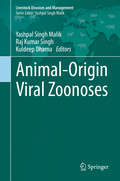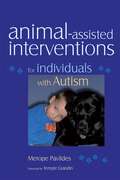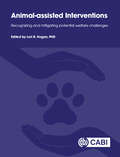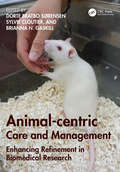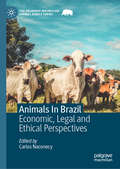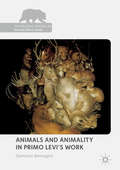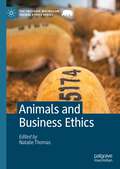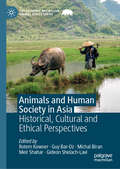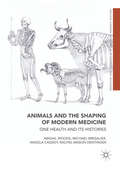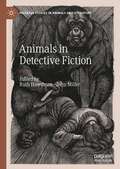- Table View
- List View
Animal Restraint for Veterinary Professionals
by Teresa F. Sonsthagen James A. Topel C. C. SheldonThis book was designed to provide a pictorial guide to common animal restraints. This text demonstrates accepted veterinary handling and restraint techniques drawn from our personal experiences and time-tested handling and restraint techniques used by the veterinary profession. It also integrates handling and restraint theory with step-by-step discussion and digital camera images.
Animal Satire (Palgrave Studies in Animals and Literature)
by Susan McHugh Robert McKayAnimal Satire presents a cultural history of animal satire, a critically neglected but persistent presence in the history of cultural production, in which animals expose human folly while the strategies of satire expose the folly of human-animal relations. Highlighting the teeming animal presences across the history of satirical expression from Aristophanes to Twitter, with chapters on key works of literature, drama, film, and a plethora of satirical media, Animal Satire reveals the rich rhetorical significance of animality in powering the politics of satire from ancient and medieval through modern and contemporary times. More pressingly, the book makes the case for the significance of satire for understanding the real-world implications of rhetoric about animals in ongoing struggles for justice. By gathering both critical and creative examples from representative media forms, historical periods, and continents, this volume aims to enrich scholarship on the history of satire as well as empower creative practitioners with ideas about its practical applications today.
Animal Sourced Foods for Developing Economies: Preservation, Nutrition, and Safety (World Food Preservation Center Book Series)
by Muhammad Issa Khan Aysha SameenAnimal products are good source of disposable income for many small farmers in developing countries. In fact, livestock are often the most important cash crop in many small holder mixed farming systems. Livestock ownership currently supports and sustains the livelihoods of rural poor, who depend partially or fully on livestock for their income and/or subsistence. Human population growth, increasing urbanization and rising incomes are predicted to double the demand for, and production of, livestock products in the developing countries over the next twenty years. The future holds great opportunities for animal production in developing countries. Animal Sourced Foods for Developing Economies addresses five major issues: 1) Food safety and nutritional status in developing world; 2) the contribution of animal origin foods in human health; 3) Production processes of animal foods along with their preservation strategies; 4) functional outcomes of animal derived foods; and finally, 5) strategies, issues and polices to promote animal origin food consumption. Animal sourced food contain high biological value protein and important micronutrients required for optimal body functioning but are regarded as sources of fat that contribute to the intake of total and saturated fatty acids in diet. The quality of protein source has a direct influence on protein digestibility, as a greater proportion of higher quality proteins is absorbed and becomes available for bodily functions. Animal foods has high quantity and quality of protein that includes a full complement of the essential amino acids in the right proportion. Land availability limits the expansion of livestock numbers in extensive production systems in most regions, and the bulk of the increase in livestock production will come from increased productivity through intensification and a wider adoption of existing and new production and marketing technologies. The significant changes in the global consumption and demand for animal source foods, along with increasing pressures on resources, are having some important implications for the principal production systems. In this book, contributors critically analyze and describe different aspects of animal’s origin foods. Each chapter is dedicated to a specific type of food from animal source, its nutritional significance, preservation techniques, processed products, safety and quality aspects on conceptual framework. Special attention is given to explain current food safety scenario in developing countries and contribution of animal derived food in their dietary intake. Existing challenges regarding production, processing and promotion of animal’s origin foods are also addressed with possible solutions and strengthening approaches.
Animal Suffering, Human Rights, and the Virtue of Justice
by Per BauhnIn this book, Per Bauhn does three things. First, he outlines some aspects of contemporary philosophical views on animals and morality, including the criticism of speciesism and the animal rights argument. Second, he criticizes these views, arguing that we cannot escape a speciesist perspective on morality, and that there are no good reasons why we should believe that non-human animals have moral rights. Third, he argues that cruelty against non-human animals is morally wrong, but not because animal rights are being violated but because human agents who inflict cruelty on non-human animals are failing their duty to develop in themselves the virtue of justice. This latter argument is reminiscent of Immanuel Kant’s idea that we have only indirect duties towards animals, but unlike that idea, Bauhn's argument does not depend on any causal hypothesis that humans who are cruel to animals are likely to be cruel also to their fellow humans. Instead, Bauhn's argument relies on the fact that being cruel to non-human animals and other innocent beings is conceptually and logically inconsistent with the virtue of justice – a virtue which agents are rationally required to develop in themselves.
Animal Trade, The: Evolution, Ethics and Implications
by Clive PhillipsTrade is an inevitable part of human activity and evolution, but when it involves animals there are important ethical issues that have to be considered. Animal trade is often for economic reasons only, and may be hard to justify ethically. There are significant welfare and environmental costs to animals and human society that must be carefully evaluated before such a trade is sanctioned. Controversial and thought-provoking, this text focuses on the trade in live and dead animals and animal parts. It examines the facts and figures to quantify the scope of the animal trade, concentrating mainly on farm animals, but also covering captive wildlife and companion animals. The book describes welfare, environmental, economic and cultural issues around this trade, debating important ethical considerations for everyone that uses or is otherwise involved with animals, especially people in animal welfare.
Animal Welfare
by Richard Bennett Paul Thompson David Fraser Georgia Mason Peter Sandøe Michael Appleby Anna Olsson Ignacio Viñuela-Fernández Michael Cockram Paul Hemsworth Joy Mench Ilias Kyriazakis Linda Keeling Marek Spinka Birte Nielsen Andreas Steiger Andrew Butterworth Francisco Galindo Barry Hughes Paul Hocking Dominique Blache Alain Boissy Bryan JonesThe welfare of animals continues to increase in recognition and concern throughout the world, with more and more research in the field offering new insights into the optimal conditions and treatment for the animals we live and work with. Providing a broad introduction to the key topics in the welfare of animals large and small, farm and companion, wild and zoo, this fully updated textbook covers ethics, animal pain and injury, health and disease and social conditions, welfare issues and problems, their assessment, and solutions. With contributions from renowned international experts Animal Welfare, 2nd Edition is an essential resource for students and researchers in animal and veterinary sciences.
Animal Welfare
by Richard Bennett Paul Thompson David Fraser Georgia Mason Clare Palmer Peter Sandøe Christine Nicol Daniel Weary Michael Appleby Anna Olsson Ignacio Viñuela-Fernández Michael Cockram Paul Hemsworth Joy Mench Ilias Kyriazakis Linda Keeling Marek Spinka Birte Nielsen Francisco Galindo Barry Hughes Dominique Blache Alain Boissy Bryan Jones Dr Andrew Butterworth Charlotte C. Burn Grahame J. Coleman Richard B. D’Eath Ian J.H. Duncan Cathy M. Dwyer Paul Flecknell Paul M. Hocking Stella Maris Huertas Joergen B. Kjaer Ute Knierim Shane K. Maloney Professor Michael Mendl Ruth C. Newberry Edmond A. Pajor Jeff Rushen Sally L. Sherwen Claudia Terlouw Bert Tolkamp Natalie K. Waran Francoise Wemelsfelder Nadja Wielebnowski Hanno WürbelUpdated and revised, this bestselling textbook continues to provide a broad introduction to the key topics in the welfare of animals both large and small, farm and companion, wild and zoo. It retains all the popular features of the previous editions with coverage of key issues such as ethics, animal pain and injury, health and disease, social conditions, and welfare dilemmas and problems. Importantly, it also offers practical advice for welfare assessment, with a full section dedicated to the implementation of solutions. The third edition: - Contains many more examples of welfare issues in different countries, particularly the implications for smallholders as well as larger scale agriculture - Covers fish welfare as well as welfare of amphibians, reptiles and invertebrates - Includes concepts of positive emotion and other positive aspects of welfare - Focuses on animal welfare and sustainability - Includes an integrated ebook with additional material and videos With contributions from renowned international experts and a new editorial team, Animal Welfare, 3rd Edition is an essential resource for students and researchers in animal and veterinary sciences and other disciplines considering the science and practice of animal welfare, and for practitioners and decision-makers worldwide.
Animal Welfare Science: An Interdisciplinary Guide
by Emily Patterson-Kane Tina RichAnimal welfare as a concept and practice is important to many disciplines and professions. From blue skies scientists to front line animal rescue, there is a need for this textbook, which distils and interprets the core concepts and language of animal welfare science.Coverage includes the main theories and why we needed them; practical advice for how to assess animal welfare; illustrative examples of different species and the importance of their interactions; and the stresses and strains experienced across an increasingly diverse workforce. Foundational knowledge is combined with real-world examples and recent advances to communicate the content and spirit of this unique field.This accessible text is designed to support tertiary animal welfare curricula but is also relevant to the study of human–animal interactions, anthropology, and related fields. It provides a jumping-off point for many areas of knowledge and application for anyone interested in how animal welfare and science intersect. Animal Welfare Science: An Interdisciplinary Guide was created to provide an informational grounding that fosters competency, credibility, and the confidence to engage with peers across the animal welfare space. It also provides an overview of the career landscape with practical advice about the challenges and pressure points that you may encounter. Along with copious color illustrations, bullet points, text boxes, thought experiments, tables, and links to video and other online resources aid accessibility.
Animal Welfare in Animal Agriculture: Husbandry, Stewardship, and Sustainability in Animal Production
by Bernard E. Rollin Fuller W. Bazer Wilson G. PondWhat constitutes animal welfare? With animals being used for companionship, service, research, food, fiber, and by-products, animal welfare is a topic of great interest and importance to society. As the world's population continues to increase, a major challenge for society is the maintenance of a strong and viable food system, which is linked to t
Animal Welfare in Veterinary Practice
by James YeatesA practical guide to help veterinarians improve the welfare of their patients in their everyday work. A concise and accessible introduction to welfare that is both interesting and valuable in practice.The book describes ways to evaluate patients, develop in-practice quality of life assessments, resolve difficult clinical dilemmas, and turn good decisions into real welfare outcomes. It reviews available scientific information, legal issues and ethical dilemmas, and relates these to everyday case studies throughout. It provides ways for all veterinary professionals to develop their animal welfare understanding, without assuming prior knowledge, while advancing the wisdom and abilities of experienced practitioners.Key features:Presents practical and realistic methods for working with owners to improve patients' welfare within the constraints of everyday practice.Provides useful advice for work within many legal jurisdictions.Includes summaries of research, vital references, and further reading sources.Key points are recapped at the end of each chapter.Suitable for all those working in the veterinary and related professions, including veterinarians, veterinary nurses, animal welfare scientists, animal behaviourists, paraprofessionals and lay staff.Published as a part of the prestigious Wiley-Blackwell - UFAW Animal Welfare series. UFAW, founded 1926, is an internationally recognised, independent, scientific and educational animal welfare charity. For full details of all titles available in the UFAW series, please visit www.wiley.com/go/ufaw.
Animal Welfare in a Changing World
by Temple Grandin David A. Fennell Tomas Norton Paul C. Paquet Elly Hiby Mark Jones Conor Ryan Philip Lymbery Dr Andrew Butterworth Rebecca Aldworth Shelley M. Alexander Regina Asmutis-Silvia Panayiotis Panos Azmanis Prof Daniel Berckmans Lotta Berg Harry Blokhuis Xavier Boivin Dr John Bradshaw Prof. Victoria Braithwaite Stijn Bruers Henry Buller Joyce D’Silva Sarah Dolman Chris Draper Dr Charles Foster Taryn Glass Adam Hart Dr Sophia Hepple Kristof Hermans Dr Miel Hostens Michael J Kuba Miriam Martin Geert Opsomer Maria Panagiotopoulou Mark Simmonds Kalliopi Stara Rigas Tsiakiris Dr Bonny Ranst Paul Whittington Dr James YeatesContemporary and challenging, this thought-provoking book outlines a number of the key dilemmas in animal welfare for today's, and tomorrow's, world. The issues discussed range from the welfare of hunted animals, to debates around intensive farming versus sustainability, and the effects of climate and environmental change. The book explores the effects of fences on wild animals and human impacts on carrion animals; the impacts of tourism on animal welfare; philosophical questions about speciesism; and the quality and quantity of animal lives. The welfare impacts of human-animal interactions are explored, including human impacts on marine mammals, fish, wildlife, and companion and farm animals. Animal Welfare in a Changing World provides: Concise, opinion-based views on important issues in animal welfare by world experts and key opinion leaders. Pieces based on experience, which balance evidence-based approaches and the welfare impacts of direct engagement through training, campaigning and education. A wide-ranging collection of examples and descriptions of animal welfare topics which outline dilemmas in the real world, that are sometimes challenging, and not always comfortable reading. This is a 'must-read' book for animal and veterinary scientists, ethologists, policy and opinion leaders, NGOs, conservation biologists and anyone who feels passionately about the welfare of animals
Animal Welfare in a Changing World
by Temple Grandin David A. Fennell Tomas Norton Paul C. Paquet Andrew Butterworth Elly Hiby Mark Jones Conor Ryan Philip Lymbery Rebecca Aldworth Shelley M. Alexander Regina Asmutis-Silvia Panayiotis Panos Azmanis Prof Daniel Berckmans Lotta Berg Harry Blokhuis Xavier Boivin Dr John Bradshaw Prof. Victoria Braithwaite Stijn Bruers Henry Buller Joyce D’Silva Sarah Dolman Chris Draper Dr Charles Foster Taryn Glass Adam Hart Dr Sophia Hepple Kristof Hermans Dr Miel Hostens Michael J Kuba Miriam Martin Geert Opsomer Maria Panagiotopoulou Mark Simmonds Kalliopi Stara Rigas Tsiakiris Dr Bonny Ranst Paul Whittington Dr James YeatesContemporary and challenging, this thought-provoking book outlines a number of the key dilemmas in animal welfare for today's, and tomorrow's, world. The issues discussed range from the welfare of hunted animals, to debates around intensive farming versus sustainability, and the effects of climate and environmental change. The book explores the effects of fences on wild animals and human impacts on carrion animals; the impacts of tourism on animal welfare; philosophical questions about speciesism; and the quality and quantity of animal lives. The welfare impacts of human-animal interactions are explored, including human impacts on marine mammals, fish, wildlife, and companion and farm animals. Animal Welfare in a Changing World provides: Concise, opinion-based views on important issues in animal welfare by world experts and key opinion leaders. Pieces based on experience, which balance evidence-based approaches and the welfare impacts of direct engagement through training, campaigning and education. A wide-ranging collection of examples and descriptions of animal welfare topics which outline dilemmas in the real world, that are sometimes challenging, and not always comfortable reading. This is a 'must-read' book for animal and veterinary scientists, ethologists, policy and opinion leaders, NGOs, conservation biologists and anyone who feels passionately about the welfare of animals
Animal Welfare in a Pandemic: What Does COVID-19 Tell us for the Future? (CRC One Health One Welfare)
by John T. Hancock Ros C. Rouse Tim J. CraigAnimal Welfare in a Pandemic explores the impact of COVID-19 on a wide array of animals, from those in the wild to companion and captive animals. During the height of the pandemic, a range of animals were infected, and many died, but this was hard to predict, even using up-to-date bioinformatics. Lockdowns around the world had, and continue to have, a major effect on animals’ welfare, influencing pet ownership and care, as well as impacting on the work of conservation institutes due to the lack of visitors and funding and lack of tourist presence in the wild which impacted on anti-poaching efforts. Some of the vast amount of personal protection equipment (PPE) that was distributed was discarded, creating both dangers and occasional opportunities for wild animals. With the rollout of human vaccines, some countries started developing animal vaccines, only some of which were deployed. In summary, the pandemic had a wide-ranging influence on animal welfare around the world. This is reviewed to highlight what can be learned to protect and enhance animal welfare in future epidemics/pandemics, and contribute to a genuinely One Health approach where the health and welfare of both humans and animals are considered holistically.This book is authored by members of the University of the West of England, Bristol, who span a range of expertise in Biological Sciences, Social Sciences, Animal Welfare, and Ethics.
Animal Welfare: Understanding Sentient Minds and Why It Matters (UFAW Animal Welfare #3)
by John WebsterAnimal Welfare An Accessible Overview of the Concept of Sentience Throughout the Animal Kingdom and Why It Matters to Humans Animal Welfare explores the concept of sentience and the development of sentient minds throughout the animal kingdom. The work provides improved definitions and analysis of the ideas of sentience, cognition, and consciousness, along with evidence of advanced mental formulation in birds, fish, and invertebrates. Considerations between humans and animals are also discussed, such as outcome-based ethics in relation to humans’ duties of care and the rights and wrongs of domestication. The work is divided into three parts and covers key topics such as: Specifics of animal sentience, from pain and suffering, to fear and dread, all the way to animals’ social life and the comfort/joy/hope/despair they experience What we know about the sentience of different classes of animals in the waters, air, savannah/plains, and forests Considerations on human interactions based on animal sentience, including death (killing), animal farms, animals in laboratories, wild animals in captivity, and animals in sports and entertainment Analysis on what humans can learn from animals based on what we know about their varying levels of sentience Animal Welfare serves as an invaluable analysis of animal sentience for students, teachers, and professionals directly involved in the study, teaching, and applications of animal behavior, motivation, and welfare. Thanks to the wide-ranging implications of animal sentience, the work will also appeal to everyone with a broader interest in animal behavior and human/animal interactions.
Animal-Assisted Intervention: Thinking Empirically
by Angela K. FournierThis book brings the animal into the scholarly discussion of animal-assisted therapy and other interventions. Challenging the current reliance on outcome studies, the author offers a new way of thinking empirically about animal-assisted interventions—analysis of human-animal interaction as a critical component. Through empirical demonstrations from laboratory and applied settings, the book encourages practitioners and scholars to undergo a deeper examination of the basic interactions that occur between clients or patients and therapy animals. Dr. Fournier provides new ideas on measurement, experimentation, and interpretation of human-animal interaction, aimed at identifying the role of the animal in interventions for human health and well-being.
Animal-Origin Viral Zoonoses (Livestock Diseases and Management)
by Kuldeep Dhama Yashpal Singh Malik Raj Kumar SinghThis book is the second volume in the series Livestock Diseases and Management, and reviews the importance and implications of animal origin viral zoonoses. It also highlights the specific etiology and epidemiology of these viral infections and discusses their various biological and mechanical transmission mechanisms. Further, the book reviews various measures for controlling viral zoonoses and examines novel therapeutic and prophylactic strategies.Discussing recent studies on the pathogenesis and host immune response to these infections, it underscores the importance of using vaccines against these viral diseases to reduce the risk of them being transmitted to humans.Lastly, it describes in detail the challenges posed by these viral infections and our readiness to face them.
Animal-assisted Interventions for Individuals with Autism
by Temple Grandin Merope PavlidesThis book looks at how therapies involving animals can be used to help individuals with autism to develop skills, including sensory and social skills, to manage challenging behaviors, and improve quality of life. Whether participating in therapeutic horseback riding, utilizing a trained service dog, visiting a dolphin therapy center, or simply experiencing companion animal therapy, people with autism can reap a multitude of benefits from interaction with furry, feathered, and finned friends. Merope Pavlides relates the success stories of different animal-assisted interventions, as well as noting the challenges of working with particular animal species. She also emphasizes the importance of tailoring interventions to the specific needs of the individual and of monitoring progress. With recommendations for resources and further reading, this book will be of great interest to people with autism, their parents, and the professionals who work with them.
Animal-assisted Interventions: Recognizing and Mitigating Potential Welfare Challenges
by Temple Grandin Helen Lewis Amy Johnson Susan D. Greenbaum Ashley Thompson Aubrey H. Fine Veronica Lac Patti Anderson Nicky Barendrecht-Jenken Anna Van Berg Darlene Blackman Eileen Bona Donna Clarke Linda Chassman Craddock Yvonne Eaton-Stull Cynnie Foss Angela Fournier Megan French Nina Ekholm Fry Lisa-Maria Glenk Taylor Chastain Griffin Joy R. Hanson Terri Hlava Ann R. Howie Batya Gugenheim Jaffe Suzanne M. Kapral Jean Kirnan Ursula A. Kohl Elizabeth A. Letson Kirsty MacQueen Arieahn Matamonasa-Bennett Angela M. Moe Julie Ann Nettifee Zenithson Ng Brittany Panus Caiti Peters Laura Poleshuck Missy Reed Elizabeth Ruegg Brenda Rynders Sarah Schlote Shira Smilovici Risë VanFleet Melissa Y. Winkle Katrina WinsorThis is a practical book exploring how to conduct animal assisted intervention (AAI) in ways that protect and prioritize animal and human welfare. This resource is for social scientists (e.g., psychology, social work, human development and family studies, etc.), as well as ethologists and animal behaviour and welfare students and practitioners. The book is a series of short chapters that depict a wide array of AAIs and their potential welfare concerns. The chapters include descriptions of the AAI offered, the welfare challenges, and ways to successfully mitigate these challenges. This book also covers critical topics including therapy animals' aging, retirement, and death as well as ethical issues including animal consent. Species include not only dogs, but horses, rabbits, and other small animals (e.g., guinea pigs, mice, etc.). Types of AAI involve individual interventions as well as crisis dogs (those who help after natural and man-made disasters), and residential animals. The book is designed to be a practical, engaging book with links to video and examples of real-life situations. It is evidence-based, yet user-friendly and directly applicable to students and practitioners. This highly practical and engaging book with examples of real life situations, videos and case studies, explores how to conduct animal assisted interventions in ways that protect and prioritize animal and human welfare. The book: · Explores how to conduct animal assisted intervention (AAI) in ways that protect and prioritize animal and human welfare. · Discusses potential welfare challenges including how to advocate for the animal, animal consent, and the animal's aging, retirement, or death. · Evidence based approach to mitigating welfare concerns for a wide range of therapy animals including dogs, horses, rabbits, rodents, and exotic animals - and their recipients. An invaluable resource for ethologists and animal behaviour and welfare students and practitioners, as well as social scientists (e.g., psychology, social work, human development and family studies).
Animal-centric Care and Management: Enhancing Refinement in Biomedical Research
by Dorte Bratbo Sørensen, Sylvie Cloutier, and Brianna N. GaskillThe concept of the 3Rs (Refinement, Reduction and Replacement) has been used as a framework for improving the welfare of laboratory animals for the last half century. By establishing an animal-centric view on housing and management, Animal-centric Care and Management: Enhancing Refinement in Biomedical Research takes Russell and Burch’s definition of Refinement as "elimination of inhumanities" and goes further. Rather than fitting animals into experimental conditions, it encourages readers to adjust conditions to better meet the behavioral, emotional, physical, and physiological needs and preferences of the animals. The team of expert authors, from the fields of laboratory animal science, ethology, biology as well as animal training, provide ideas for creating housing conditions and handling procedures that induce, to the best of current abilities and knowledge, a long-term positive state of mind in the animals under our care. This book is written for animal caretakers, animal health technicians, researchers, animal facility managers, laboratory animal veterinarians, and anyone who engages in work with living experimental animals or is interested in the continuous improvement of laboratory animal welfare. This interdisciplinary guide will act as a catalyst, resulting in multiple viewpoints and fields collaborating to optimize laboratory animal welfare.
Animals In Brazil: Economic, Legal and Ethical Perspectives (The Palgrave Macmillan Animal Ethics Series)
by Carlos NaconecyThis book presents a collection of essays exploring the legal, economic, socio-environmental, and ethical dimensions of human-animal interaction in Brazil. As one of the primary global producers and exporters of beef, with a level of biodiversity in its rain-forests found nowhere else under threat, the importance of Brazil for animal life is unquestionable. Shedding light on the profound transformations in the consumption and production of animal-sourced foods that have taken place over the last five decades, the authors examine the consequences of this phenomenon for the lives of animals, the health of the population, and the environment. The book also offers an analysis of the animal welfare and animal protection legislation in Brazil, before presenting a number of notable cases involving animal advocacy and activism in recent years. An important and timely collection, this book concludes with an exploration of the historical, socio-cultural and economic aspects that influence the Brazilian ethos regarding the morality of the treatment of animals.
Animals and Animality in Primo Levi’s Work (The Palgrave Macmillan Animal Ethics Series)
by Damiano BenvegnùSituated at the intersection of animal studies and literary theory, this book explores the remarkable and subtly pervasive web of animal imagery, metaphors, and concepts in the work of the Jewish-Italian writer, chemist, and Holocaust survivor Primo Levi (1919-1987). Relatively unexamined by scholars, the complex and extensive animal imagery Levi employed in his literary works offers new insights into the aesthetical and ethical function of testimony, as well as an original perspective on contemporary debates surrounding human-animal relationships and posthumanism. The three main sections that compose the book mirror Levi’s approach to non-human animals and animality: from an unquestionable bio-ethical origin (“Suffering”); through an investigation of the relationships between writing, technology, and animality (“Techne”); to a creative intellectual project in which literary animals both counterbalance the inevitable suffering of all creatures, and suggest a transformative image of interspecific community (“Creation”).
Animals and Business Ethics (The Palgrave Macmillan Animal Ethics Series)
by Natalie ThomasThis book engages with some of the most pressing ethical issues that arise from the use of animals in various business practices, providing interdisciplinary approaches to improving the nonhuman and human lives in animal-related industries. The chapters in this volume provide conceptual, theoretical and practical analyses of these issues that will shape the future direction of business ethics to more fully refl ect the impacts and implications of animal-based businesses on society, its members, and nature. The authors in this volume engage with topics including animal suffering and emotions, the commodifi cation of animals, vegetarian and vegan businesses and diets, technological innovations such as gene editing and lab-cultured meat, as well as captivity, corporate disclosure of animal welfare policies, and the possibility of humane jobs as well as the consideration of animals as stakeholders.
Animals and Human Society in Asia: Historical, Cultural and Ethical Perspectives (The Palgrave Macmillan Animal Ethics Series)
by Rotem Kowner Michal Biran Gideon Shelach-Lavi Meir Shahar Guy Bar-OzThis edited collection offers a comprehensive overview of the different aspects of human-animal interactions in Asia throughout history. With twelve thematically-arranged chapters, this book examines the diverse roles that beasts, livestock, and fish — real and metaphorical– have played in Asian history, society, and culture. Ranging from prehistory to the present day, the authors address a wealth of topics including the domestication of animals, dietary practices and sacrifice, hunting, the use of animals in war, and the representation of animals in literature and art. Providing a unique perspective on human interaction with the environment, the volume is cross-disciplinary in its reach, offering enriching insights to the fields of animal ethics, Asian studies, world history and more.
Animals and the Shaping of Modern Medicine: One Health and its Histories (Medicine and Biomedical Sciences in Modern History)
by Angela Cassidy Abigail Woods Michael Bresalier Rachel Mason DentingerThis book is open access under a CC BY 4. 0 license. This book breaks new ground by situating animals and their diseases at the very heart of modern medicine. In demonstrating their historical significance as subjects and shapers of medicine, it offers important insights into past animal lives, and reveals that what we think of as 'human' medicine was in fact deeply zoological. Each chapter analyses an important episode in which animals changed and were changed by medicine. Ranging across the animal inhabitants of Britain's zoos, sick sheep on Scottish farms, unproductive livestock in developing countries, and the tapeworms of California and Beirut, they illuminate the multi-species dimensions of modern medicine and its rich historical connections with biology, zoology, agriculture and veterinary medicine. The modern movement for One Health - whose history is also analyzed - is therefore revealed as just the latest attempt to improve health by working across species and disciplines. This book will appeal to historians of animals, science and medicine, to those involved in the promotion and practice of One Health today.
Animals in Detective Fiction (Palgrave Studies in Animals and Literature)
by John Miller Ruth HawthornThis book explores the vast array of animals that populate detective fiction. If the genre begins, as is widely supposed, with Edgar Allan Poe’s “Murders in the Rue Morgue” (1841), then detective fiction’s very first culprit is an animal. Animals, moreover, consistently appear as victims, clues, and companions, while the abstract conception of animality is closely tied to the idea of criminality. Although it is often described as an essentially conservative form, detective fiction can unsettle the binary of human and animal to intersect with developing concerns in animal studies: animal agency, the ethical complexities of human/animal interaction, the politics and literary aesthetics of violence, and animal metaphor. Gathering its 14 essays into sections on ontologies, ethics, politics, and forms, Animals in Detective Fiction provides a compelling and nuanced analysis of the central role creatures play in this enduringly popular and continually morphing literary form.
